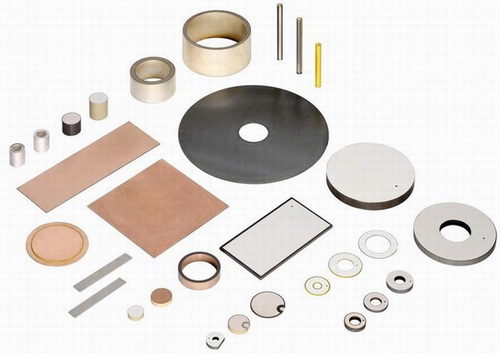Abstract
Содержание
Introduction
It is difficult to name an area of scientific, engineering and artistic activity that would enjoy such attention as the creation of ceramics. Historically, ceramics meant products and materials obtained by sintering clays and their mixtures with mineral additives. It is difficult to set a date when ceramics, which is now called high-tech, entered the industrial arena. Probably the first type of such ceramics was silicon carbide, the production of which one of the American companies began almost 100 years ago. Already at that time, the term ceramics
acquired a broader meaning: in addition to traditional materials made of clays, it began to include materials obtained from pure, simple and complex oxides, carbides, nitrides, etc.
In the world of modern materials ceramics plays a significant role due to a wide range of its various physical and chemical properties. Ceramics is not oxidized and stable in a higher temperature region than metals, for example, the melting point of hafnium carbide (3930 °C) is 250 °C higher than that of tungsten. In common ceramic materials (oxides of aluminum, magnesium, thorium) thermal stability is much higher than the stability of most steels and alloys. The modulus of elasticity of ceramic fibers is an order of magnitude higher than that of metals.
Crystalline substances in which the compression or tension in certain directions there is an electric polarization, even in the absence of an external electric field, called piezoelectrics (and the effect – piezoelectric or piezoelectric). The appearance of mechanical deformation under the influence of an electric field is called the inverse piezoelectric effect.
Some crystals when heated can acquire an electric charge: positive at one end and negative at the opposite. This phenomenon is called pyroelectricity.
Pyroelectrics are crystalline dielectrics with spontaneous polarization, that is, polarization in the absence of an electric field and other external influences. Such polarization occurs as a result of mismatch of centers of gravity
of positive and negative charges in polar dielectrics.
Ferroelectrics (ferroelectrics) are crystalline dielectrics possessing in a certain temperature range (and not in any, as in the case of pyroelectrics) spontaneous polarization, which can be changed by an external field [1, 2].
Piezoceramics is an artificial material with piezoelectric and ferroelectric properties, having a polycrystalline structure. Some of its types are shown in figure 1.

Figure 1 – Piezoelectric ceramics, used in medicine
1. Theme urgency
When certifying samples, an important point is the choice of the optimal sintering temperature, which significantly affects the electrophysical properties. At the same time, not all factors affecting the competent behavior of the process (initial raw materials, composition, temperature shrinkage interval, etc.) are often taken into account. Therefore, the study of this process for specific materials is an important and urgent task.
2. Goal and tasks of the research
The aim of this work is to investigate the sintering signaturestat transistorise of piezoelectric ceramics to provide high-level and voproizvodit properties.
Main tasks of the research:
- To study the effect of physico-chemical status of the initial components on the synthesis temperature of the material STST– 3.
- Find out the causes of nanoproizvodstva electrical properties
signaturestat
andmedium hard
piezoelectric ceramics. - To analyze the compositions of the content of the components.
- To study the process of decomposition of strontium carbonate.
- Select the optimal mode of sintering strontium-containing piezoceramics.
- Summarize the results.
Conclusion
According to the results of the work, the following conclusions can be drawn:.
- The application of piezoceramics at the present stage of development is described.
- The choice of the method of piezoceramics synthesis is substantiated, the corresponding technological scheme is given.
- The role of modifying additives in the formation of material properties is shown.
This master's work is not completed yet. Final completion: June 2019. The full text of the work and materials on the topic can be obtained from the author or his head after this date.
References
- Игнатенко, П. И. Физика материалов/ П. И. Игнатенко, Н. П. Иваницын. – Донецк: ДГУ, 1999. – 235 с.
- Веневцев, Ю. Н. Сегнето- и антисегнетоэлектрики семейства титаната бария/ Ю. Н. Веневцев, Е. Д. Политова, С. А. Иванов. –М.: Химия, 1985. – 256 с.
- Жукова, С. Н. Пьезоэлектрическая керамика: принципы и применение/ С. Н. Жукова. –Мн. ООО «ФУА Информ», 2003. – 112 с.
- Приседский В. В. Нестехиометрические сегнетоэлектрики AIIBIVO3: монография/ В.В. Приседский. – Донецк: Ноулидж, 2011. – 267 с.
- Климов В. В. Пьезокерамические материалы для электронной техники/ В.В. Климов,О. С. Дидковская. –М.: НИИТЭХИМ, 1991. – 33 – 34 с.
- Головнин, В. А. Мир материалов и технологий/ В. А. Головнин, И. А. Каплунов, О. В. Малышкина, Б. Б. Педько, А. А. Мовчикова. –М.: Техносфера, 2016. – 272 с.
- Фесенко, Е. Г. Новые пьезокерамические материалы/ Е. Г. Фесенко, А. Я. Данцигер, О. Н. Разумовская. – Ростов-на-Дону: Изд-во РГУ, 1983. – 160 с.
- Смажевская, Е. Г. Пьезоэлектрическая керамика/ Е. Г. Смажевская, Н. Б. Фельдман. – М.: Советское радио, 1971. – 200 с.
- Прилипко, Ю. С. Функциональная керамика. Оптимизация технологии/ Ю. С. Прилипко. – Донецк: Норд-Пресс, 2007. – 492 с.
- Поплавко, Ю. М. Физика диэлектриков/ Ю. М. Поплавко. – К.: Выща школа, 1980. – 340 с.
- Масленникова, Г. Н. Керамические материалы/ Г. Н. Масленникова, Р. А. Мамаладзе, С. Мидзута, К. Коумото. –М.: Стройиздат, 1991. – 320 с.
- Яффе, Б. Пьезоэлектрическая керамика/ Б. Яффе, У. Кук, Г. Яффе. –М.: Мир, 1974. – 288 с.
- Жуковицкий, А. А. Физическая химия/ А. А. Жуковицкий, Л. А. Шварцман. –М.: Металлургия, 1987. – 688 с.
